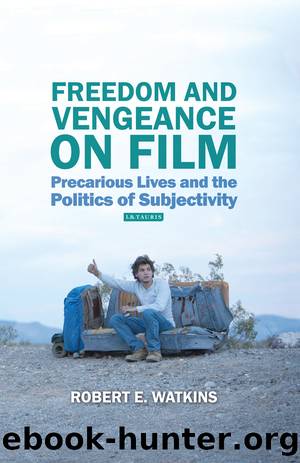Freedom and Vengeance on Film by Watkins Robert E.;

Author:Watkins, Robert E.;
Language: eng
Format: epub
ISBN: 4890536
Publisher: I. B. Tauris & Company, Limited
Published: 2016-08-14T16:00:00+00:00
Subverting Revenge and Affirming Precariousness
Another trope familiar to many Westerns that is subverted by Three Burials is the central drive for vengeance. Although vengeance is now rather ubiquitous in movies and popular culture, it is worth remembering the central role of the Western in “teaching” Americans about the necessity and legitimacy of violent revenge. In fact, the drive for vengeance is so structured into the makeup of the genre that it “reproduces itself in a thousand Western novels and movies,” insists Jane Tompkins. In most Westerns, “Vengeance, by the time it arrives, feels biologically necessary.”32 By contrast, the main engine of Three Burials’ plot is not vengeance, but something rather more interesting and complicated. While Pete’s quest for justice for his murdered friend “Mel” does provide the narrative energy of Three Burials, it becomes clear about a third of the way into the film that justice will not come in the usual vengeful form of “an eye for an eye.” For once Pete learns that Norton shot Melquiades, he does not seek to kill him in turn, but instead kidnaps him, forces him to dig up Melquiades’ body, and journey on horseback to Mexico to return Mel to his home. Before they set off for Mexico, however, Pete forces Norton to walk a mile in Melquiades’ shoes, literally, taking him to Melquiades’ house and making him sit in his chair, drink from his cup, and finally put on his clothes. Such a forced identification of perpetrator with the other suggests that Pete is not driven in the customary, generic manner by a desire for murderous vengeance, but rather that he acts as an agent of empathy, mourning, and a different understanding of social relations than is customary in most movies, let alone Westerns.
As much as The Three Burials of Melquiades Estrada is in essential ways a meditation on the “impropriety of action” in the circumstances of Melquiades’ shooting, the three interments of the title also constitute an extended reflection on another theme related to political ontology: grievability. Indeed, perhaps more than any other film in recent memory Three Burials engages the question of grievability, or “who is grievable?” That is, whose lives matter enough to be mourned when lost. This question is not as simple as it may appear, for it harbours deep undercurrents related not just to identity and culture but also to ontology and politics. For the “mattering” of lives is not simply a function of individual choice or abstract right, but rather a function of shared social norms. Judith Butler has done much to raise grievability as a political and philosophical question in recent books, most notably Precarious Life (2004) and Frames of War (2009), arguing that “Only under conditions in which the loss would matter does the value of the life appear. Thus, grievability is a presupposition for the life that matters.”33 In charting the journey of Melquiades’ body through three different burials, each with its own socio-political valences, the film emphatically challenges the dominant understanding
Download
This site does not store any files on its server. We only index and link to content provided by other sites. Please contact the content providers to delete copyright contents if any and email us, we'll remove relevant links or contents immediately.
Call Me by Your Name by André Aciman(20351)
Ready Player One by Cline Ernest(14497)
How to Be a Bawse: A Guide to Conquering Life by Lilly Singh(7364)
Wiseguy by Nicholas Pileggi(5650)
The Kite Runner by Khaled Hosseini(5062)
On Writing A Memoir of the Craft by Stephen King(4847)
Audition by Ryu Murakami(4822)
The Crown by Robert Lacey(4710)
Call me by your name by Andre Aciman(4600)
Gerald's Game by Stephen King(4556)
Harry Potter and the Cursed Child: The Journey by Harry Potter Theatrical Productions(4429)
Dialogue by Robert McKee(4306)
The Perils of Being Moderately Famous by Soha Ali Khan(4156)
Dynamic Alignment Through Imagery by Eric Franklin(4100)
Apollo 8 by Jeffrey Kluger(3621)
Seriously... I'm Kidding by Ellen DeGeneres(3564)
The Inner Game of Tennis by W. Timothy Gallwey(3557)
How to be Champion: My Autobiography by Sarah Millican(3544)
Darker by E L James(3463)
